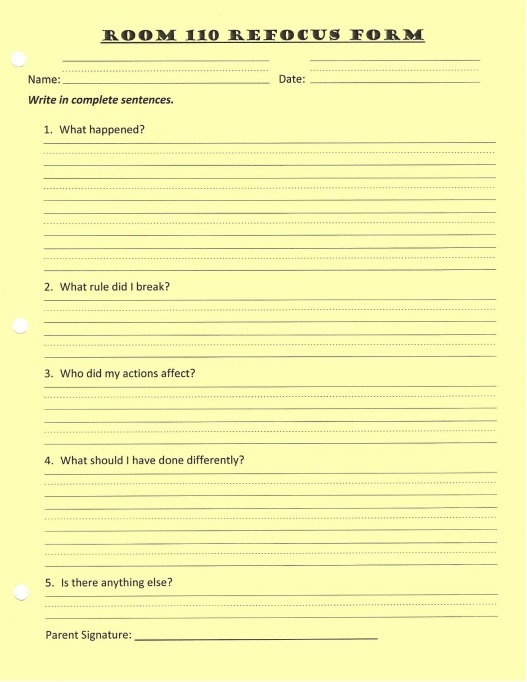Characteristics of Positive Intervention Strategies:
- Start the school year off right
- Don’t react to negative behavior immediately
- Respond positively to negative behaviors, don’t react to emotion
- Oversaturate the classroom with positivity, use five positives for every negative
- Get to know your students’ interests, likes, dislikes, music, food, sports, movies, etc.
- Get to know parents
- Get involved in student activities
- Compliment students who exhibit positive behaviors
- Consequences with empathy
- Smile, say please, and thank you
Sample Intervention Strategies:
1. Refocus Form

This is a strategy that holds students accountable for their actions. It encourages students to take time to think and reflect on what happened, who it affected, and, most importantly, what should have been done differently. This way, students and teachers can work together to brainstorm solutions to problems and prevention strategies.
2. Behavior Chart

This is a strategy that follows an individual student’s progress on a behavioral goal. The teacher and student can work together to pick a goal for the student (ex: stay in my spot) and then use the chart to record student daily ratings. A reward can also be chosen for meeting a certain goal (ex: get all smiley faces). Behavior charts can stay at school or be sent home every day for parent communication.
3. Missing Assignment Slip

This strategy keeps track of missing assignments and helps parents, students, and teachers understand why assignments are late/incomplete/missing. This allows students to reflect on their situation, explain, and brainstorm strategies for improvement.
References:
Refocus form taken from my internship classroom.
Flipping for First. (2015, September 6). Individual Student Behavior Management & Freebie. Retrieved from: http://flippingforfirst1.blogspot.com/2014/10/individual-student-behavior-mangement.html
Teach123. (2011). Missing work. Retrieved from BLOG TOPIC, http://www.teach123school.com/2012/10/the-dog-ate-it-my-mom-didnt-put-it-in.html
